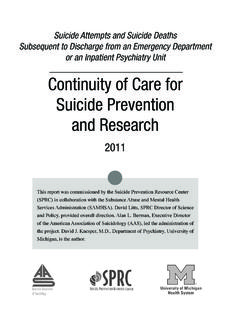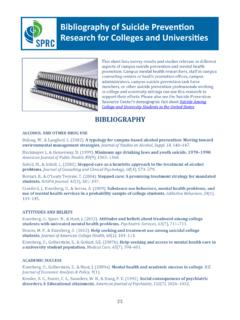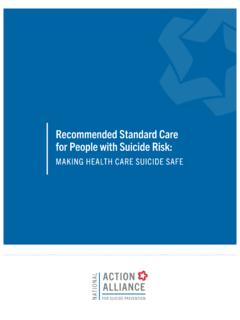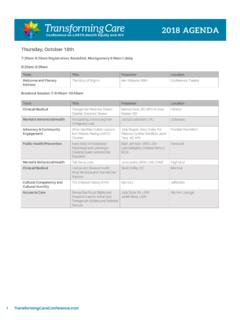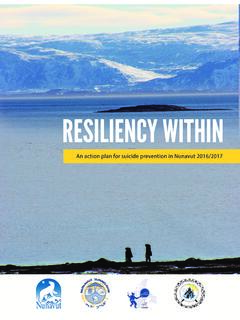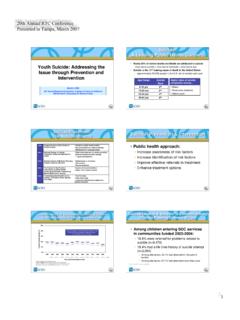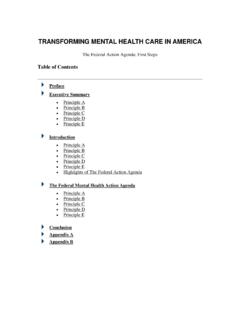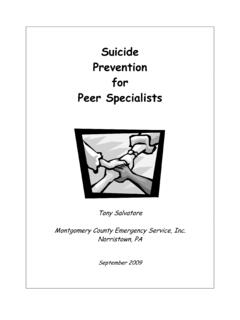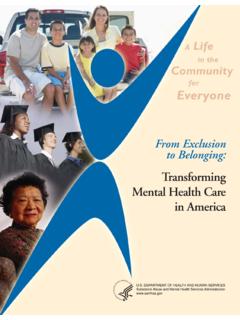Transcription of TYPE IN THE CHAT - Zero Suicide
1 EDC. 2017 All Rights Reserved. 2015-2017 EDC, Inc. All Rights IN THE CHATP lease type your name, organization, and city/state into the chat. 2015-2017 EDC, Inc. All Rights Quality Improvement in Zero SuicideMay 2, 2017 2015-2017 EDC, Inc. All Rights and DisclaimerThe Suicide prevention Resource Center at EDC is supported by a grant from the Department of Health and Human Services (HHS), Substance Abuse and Mental Health Services Administration (SAMHSA), Center for Mental Health Services (CMHS), under Grant No. 5U79SM062297. The views, opinions, and content expressed in this product do not necessarily reflect the views, opinions, or policies of CMHS, SAMHSA, or HHS. 2015-2017 EDC, Inc. All Rights Goldstein Grumet, PhDDirector of Health and Behavioral Health InitiativesSuicide prevention Resource CenterModerator 2015-2017 EDC, Inc.
2 All Rights nation s only federally supported resource center devoted to advancing the National Strategy for Suicide prevention Resource CenterPromoting a public health approach to Suicide prevention 2015-2017 EDC, Inc. All Rights #ZeroSuicide@ 2017 All Rights Reserved. 2015-2017 EDC, Inc. All Rights IS ZERO Suicide ? 2015-2017 EDC, Inc. All Rights Embedded in the National Strategy for Suicide prevention and Joint Commission Sentinel Event Alert #56. A focus on error reduction and safety in health care. A framework for systematic, clinical Suicide prevention in behavioral health and health care systems. A set of best practices and tools including Suicide 2015-2017 EDC, Inc. All Rights of Zero Suicide 2015-2017 EDC, Inc. All Rights Suicide Data Elements Worksheet 2015-2017 EDC, Inc.
3 All Rights Suicide WebsiteAccess at: 2015-2017 EDC, Inc. All Rights )Understand how data collection can be used to enhance the care that health and behavioral health care organizations provide to individuals at risk of )Describe the current status of quality improvement measures in the Suicide prevention )Describe how one organization used data to improve Suicide risk assessment ObjectivesBy the end of this webinar, participants will be able to: 2015-2017 EDC, Inc. All Rights Brian AhmedaniHenry Ford Health SystemsDr. Richard McKeonSubstance Abuse and Mental Health Services AdministrationDr. Bradley SteinfeldKaiser Permanente of Washington 2015-2017 EDC, Inc. All Rights Brian K. AhmedaniDirector of Psychiatry ResearchHenry Ford Health SystemsPresenter 2015-2017 EDC, Inc. All Rights we really need to do math?
4 There s a reason you learned math in school. You can use it to drive Suicide prevention ! 2015-2017 EDC, Inc. All Rights and Healthcare Settings Most people make a healthcare visit before Suicide . Greatest risk for Suicide is following psychiatric hospitalization (other research). Greatest number of suicides occur among general medical patients. Less than 50% of patients have MH diagnosis before Suicide . 2015-2017 EDC, Inc. All Rights and Healthcare Settings 2015-2017 EDC, Inc. All Rights Henry Ford Story Institute of Medicine Report: Crossing the Quality Chasm Robert Wood Johnson Foundation Grant Opportunity Finalist Application for Perfect Depression Care in Behavioral Health Services Department at HFHS Blues Busters Team & Governing Board (Led by Dr. Ed Coffey) Zero Suicides becomes the goal Patients, Leaders, Clinical Providers, Evaluators 75-80% Suicide rate reduction in BHS Stable Suicide rate for all Health System Patients despite a ~30% increase statewide 2015-2017 EDC, Inc.
5 All Rights from Henry Ford 2015-2017 EDC, Inc. All Rights Evaluation Quantitative Data (we re using numbers): Needs Assessment Tracking Fidelity to the Implemented Model Tracking Outcomes Informing Decisions about Ongoing Quality Improvement Root-Cause Analysis Qualitative Data (we re using expert voices/stories): Health System Leaders and Clinicians Patient Advisors (People with Lived Expertise) 2015-2017 EDC, Inc. All Rights Care Based on Outcome Data Suicide Rate per 100,000 for the full health system: Mean: ; p= BHS program may have offset 30% increase in State rate, but did not reduce overall Suicide rate Need to Expand to Primary Care 2015-2017 EDC, Inc. All Rights Track outcomes that make sense for your system: Rolling rates vs. annual rates vs. person-month rates All health system patients All patients who screen positive for Suicide All behavioral health patients Health plan population members Utilization-based denominator (based on visits) Community rates 2015-2017 EDC, Inc.
6 All Rights Care Based on Process Data Performance on Perfect Depression Care / Zero Suicide at Henry Ford has actually been measured based on fidelity (not outcomes). Fidelity Is our care TEAM completing the processes as designed? Locally defined based on the chosen Zero Suicide interventions. This is the REAL internal evaluation tool for providers and staff. 2015-2017 EDC, Inc. All Rights & Outcomes Zero Suicide Components can be measured for fidelity % of eligible patients screened. % with 7-day follow-up visit after positive screen. % with safety plan. % with means counseling. % with behavioral health visit. % with second behavioral health visit. % with 24-48 hour contact after inpatient discharge. % receiving specialty Suicide treatment. % of staff trained. 6-or 12-month change in: Organizational Self-Study Items.
7 Workforce Survey Items. 2015-2017 EDC, Inc. All Rights and Improving Care Based on Stakeholder Voices Patient Partners (and families) describe barriers and strengths. Providers share clinical barriers and strengths. Leaders describe management and system barriers and strengths. 2015-2017 EDC, Inc. All Rights :Using the chat box please share one key takeaway from Brian s presentation. 2015-2017 EDC, Inc. All Rights Richard McKeonChief of the Suicide prevention BranchSubstance Abuse and Mental Health Services Administration PresenterSAMHSA Suicide PreventionClinical Quality Measure DevelopmentSuicide prevention and Quality Measures Measuring quality is playing an increasingly important role in the health care system. There are only two approved quality measures for Suicide prevention (adult and youth risk assessment if major depression).
8 There is a need for a more robust portfolio of Suicide prevention quality measures. SAMHSA contracted with Battelle Gathering Facilitators to developing a clinical quality measure focused on an outcome of reduced Suicide deaths Challenges to Suicide prevention interventions within clinical practice Leading practices in Suicide prevention intervention within clinical practice Data and metrics to evaluate clinical Suicide prevention interventions30A peer-reviewed literature search was conducted to identify: Information Gathering Current endorsed clinical quality measures. National clinical quality measure inventories. Local Suicide prevention interventions with the same or similar constructs to those of the Zero Suicide Scan included gap analysis of:Information Gathering Conducted with internal and external stakeholders with expertise in Suicide data, Zero Suicide , and clinical Suicide prevention interventions.
9 Key informants were from various backgrounds, which encompassed practice, policy, current implementers of the Zero Suicide initiative, academia, and Veterans Informant Interviews and Technical Expert Panel: Barriers Literature review and key informant interviews pointed to gaps in, and a lack of, clinician education on how to screen for suicidal thoughts and behaviors. Gaps include a reported lack of confidence among clinicians on how to provide effective, collaborative care for suicidal patients. Without the appropriate training and education, clinicians may feel ill prepared to report on one or more Suicide prevention quality and Education: Barriers Peer-reviewed literature points to more than a dozen Suicide risk screening tools. Several key informants and subject matter experts stated that clinicians require screening and assessment tools that can be easily integrated into the healthcare and Recommendations: Barriers More than 250 clinical quality measures in the Merit-Based Incentive Payment System (MIPS).
10 22 clinical quality measures in the Inpatient Psychiatric Facility Quality Reporting (IPFQR) Program. Measures that are not harmonized with current clinical quality measures may be more difficult to institutionalize within a healthcare system. 35 Number of Quality Measures: Barriers Health system administrators, and clinicians, indicate the low number of Suicide deaths within their healthcare systems would prevent a meaningful assessment of Suicide rates. Additional data barriers include underreporting and under documentation of self-harm or Suicide attempts, as well as timely access to state death data. A clinical quality measure requiring death data may be difficult to implement at the clinician or healthcare system level. 36 Data Availability and Accessibility: Facilitators Reports such as the National Strategy for Suicide Preventionand the Suicide prevention Resource Center s (SPRC) Zero Suicide initiative have increased the emphasis on making Suicide prevention a core component of healthcare.
